Modern electric motors are complex mechanical devices that help people in solving various production problems. Without the electric motor it is hard to imagine even the simplest form of electrical equipment, which is protecting the interests of the progressive people. At first, people discovered the inexhaustible sources of electrical energy. Then, using the electric motor they made the electricity to perform time-consuming work. Today, electric motors are an essential part of any electrical equipment.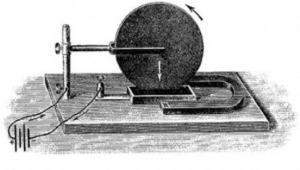
The Appearance of the Electric Motor
In 1824, British physicist and mathematician Peter Barlow using the device has demonstrated the possibility of converting electrical energy into mechanical energy. The Barlow’s Wheel consisted of two horizontal U-shaped permanent magnets, under which two copper gears are placed on the one axis. When the current passed through the wheels, they began to rotate in one direction. In this case the scientist noticed that the change of the polarity of the magnets’ poles and contacts changed the direction of rotation of the wheels. In fact, Barlow invented the first unipolar motor.
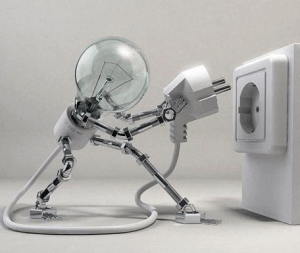
However, the first motor was not perfect, not very reliable; the whole device with batteries was cumbersome, so it was not suitable for use in industry.
The first electric motor, which has found practical application was invented in 1834 by the Russian Academician B.S. Jacobi, who in 1838 applied it to the boat moving, and then to the truck moving, putting thus the beginning of the transport electrification.
Jacobi’s motor consisted of two groups of electromagnets. Alternating polarity changing of portable electromagnets has taken place by a special switch. The principle of this device is used in some modern electric motors. The motor power was only 15 watts, with rotor speed of 80-120 rev / min.
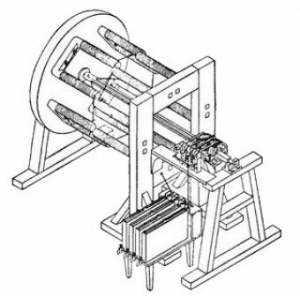
Electric Motors’ Structure
The structure of any electric motor is quite simple at first glance. This is the coil, to which the electrical pulse is transmitted and a special device that can convert electrical energy into kinetic energy, providing forward movement. Due to a simple structure electric motors are used almost everywhere today.
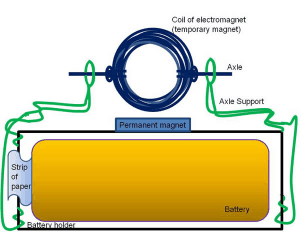
If we talk in more depth, the principle of electromagnetic induction is in the basis of the electric motors’ performance. The electric motor includes a stator (stationary part) and rotor (moving part). With the help of an electric current (or permanent magnets) fixed and / or rotating magnetic fields are appeared in the electric motor.
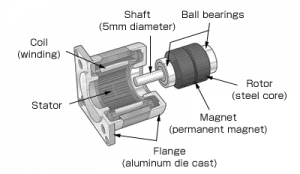 The stator is fixed, usually the outer part of the electric motor. Functions of the stator depend on the type of motor: it is capable of generating a stationary magnetic field and consists of permanent magnets and / or electromagnets, and creates a rotating magnetic field and consists of coils powered with alternating current as well.
The stator is fixed, usually the outer part of the electric motor. Functions of the stator depend on the type of motor: it is capable of generating a stationary magnetic field and consists of permanent magnets and / or electromagnets, and creates a rotating magnetic field and consists of coils powered with alternating current as well.
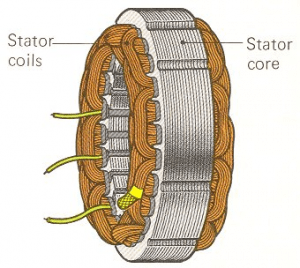
Rotor is a portable, usually located inside the stator, part of the electric motor. It may contain:
– permanent magnets;
– coils on the iron, through which electrical currents flow
– (plugged through a commutator);
short-circuited coil (“vicious circle” / “squirrel cage”), in which the currents arise under the action of the rotating stator magnetic field).

Due to the interaction of magnetic fields of the rotor and stator the torque occurs in the electric motor, which sets the rotor of the electric motor in motion. So is the conversion of electrical energy supplied to the motor coils, into mechanical energy of rotation. This energy is used to set machinery in motion.
To power the electric motor in different fields of its use permanent sources and batteries can be used. The most notable example is the use of electric motors in automotive applications. In recent years, more and more often the news about that people transplanted to electric cars are heard. In fact, the history of creation of these devices is more than a century. The first electric cars appeared in the late XIX century and were designed to meet the needs of golfers.
Types of Electric Motors
Modern industry produces various types of electric motors, depending on the production problems they face with. First of all, by the nature of the current electric motors are divided into direct and alternating current motors.
1) DC motors may have a different way of excitation: separately excited, series or dual-field.
ü Separately excited motors during the shaft load changing in a wide range change their speed a little. Therefore, they are used in cases where it is important that the working speed of the machinery remained approximately constant during light run and at any workload.
ü Series motors are characterized by the fact that the speed of rotation to a large extent determined by the shaft load. At low loads, the electric motor speed of rotation is high and when the load increases, it is dramatically reduced. Operation of these motors is prohibited without a load, as this speed of rotation can increase to a value at which the mechanical damage to the electric motor is possible. These electric motors can withstand considerable overload.
ü The characteristics of the dual-field motors are the average between the characteristics of separately excited and series motors.
2) Among the alternating current motors there are several types that can be defined: 3-phase asynchronous and 3-phase synchronous motors.
ü 3-phase asynchronous motors with short-circuited rotor are the most common in industrial plants. These electric motors, for all its simplicity, have a number of specific features, especially with regard to the conditions of starting, reversing and braking. Wound-rotor induction motors are widely used. Rotor winding clamps in such motors are displayed on rings that allow changing the conditions of starting, reversing and braking, implementing additional starting and braking resistances into the rotor circuit. The speed of rotation of asynchronous motors in normal operation does not depend much on the shaft load. In this respect they are similar to the separately excited DC motors. However, the capabilities of asynchronous motors concerning the speed control are very limited. Therefore, asynchronous motors with short-circuited rotor in a normal operation, as a rule, are used in electric equipment not requiring speed control.
ü Synchronous motors are used in non-reversible uncontrolled electric drives working for a long time, without frequent starting and braking. As a rule, they are produced at a power above 50 kW.
This is only a small part of available to the human electric motors. The selection of the most suitable motor is made depending on the type of electrical equipment and the production problems. Electric motors are widely used due to a number of their advantages such as high energy performance, ease of input and output of energy, the ability to perform various electric motor capacities, speeds of rotation and ease of maintenance and use.
But we should remember that all electric motors are the source of increased danger to human life and health, working with which people should observe certain safety precautions.
Modern electric motors are complex mechanical devices that help people in solving
Modern electric motors are complex mechanical devices that help people in solving various production problems. Without the electric motor it is hard to imagine even the simplest form of electrical equipment, which is protecting the interests of the progressive people. At first, people discovered the inexhaustible sources of electrical energy. Then, using the electric motor they made the electricity to perform time-consuming work. Today, electric motors are an essential part of any electrical equipment.
various production problems. Without the electric motor it is hard to imagine even the simplest form of electrical equipment, which is protecting the interests of the progressive people. At first, people discovered the inexhaustible sources of electrical energy. Then, using the electric motor they made the electricity to perform time-consuming work. Today, electric motors are an essential part of any electrical equipment.




